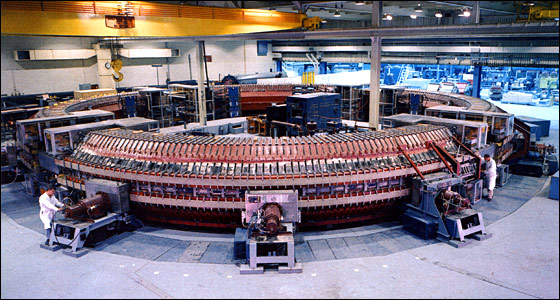Stop 2
The Cosmotron

In front of you is a cluster of interconnected buildings where the Superconducting Magnet Division designs, builds, and tests state-of-the-art magnets for particle accelerators and experimental facilities around the world. See the sample magnet for the Relativistic Heavy Ion Collider on the lawn? You’ll learn more about that later in the tour.
In the back, you can see the roof of the building that once housed Brookhaven’s first high-energy particle accelerator — the Cosmotron. It operated from 1952 until 1966. In 1956, experiments at the Cosmotron inspired researchers to make a discovery that won them the 1957 Nobel Prize in Physics — Brookhaven’s first of seven Nobel Prizes. The Cosmotron was a circular proton accelerator 75 feet in diameter that weighed 2,000 tons. It was composed of 288 C-shaped magnets that guided beams of particles called protons, which form part of the nucleus of atoms.
The Cosmotron was the first accelerator in the world to accelerate particles to energies in the billion-electron-volt region. When the Cosmotron reached its full design energy of 3.3 billion electron volts in January 1953, protons traveled more than 9.5 millions laps around the accelerator ring — 135,000 miles — after only one second of acceleration.
When it was built, the Cosmotron was the world's highest-energy accelerator and the first accelerator of its kind to provide proton beams for experiments outside the accelerator ring. After leaving the ring, the protons would strike a target and fragments from the collision were observed in photographs that showed the telltale trails left in cloud chambers and other detectors. Early on, the intensity of the beam was ten billion protons per pulse. By 1966, the last year of operation, the intensity had been increased nearly 100 times.


